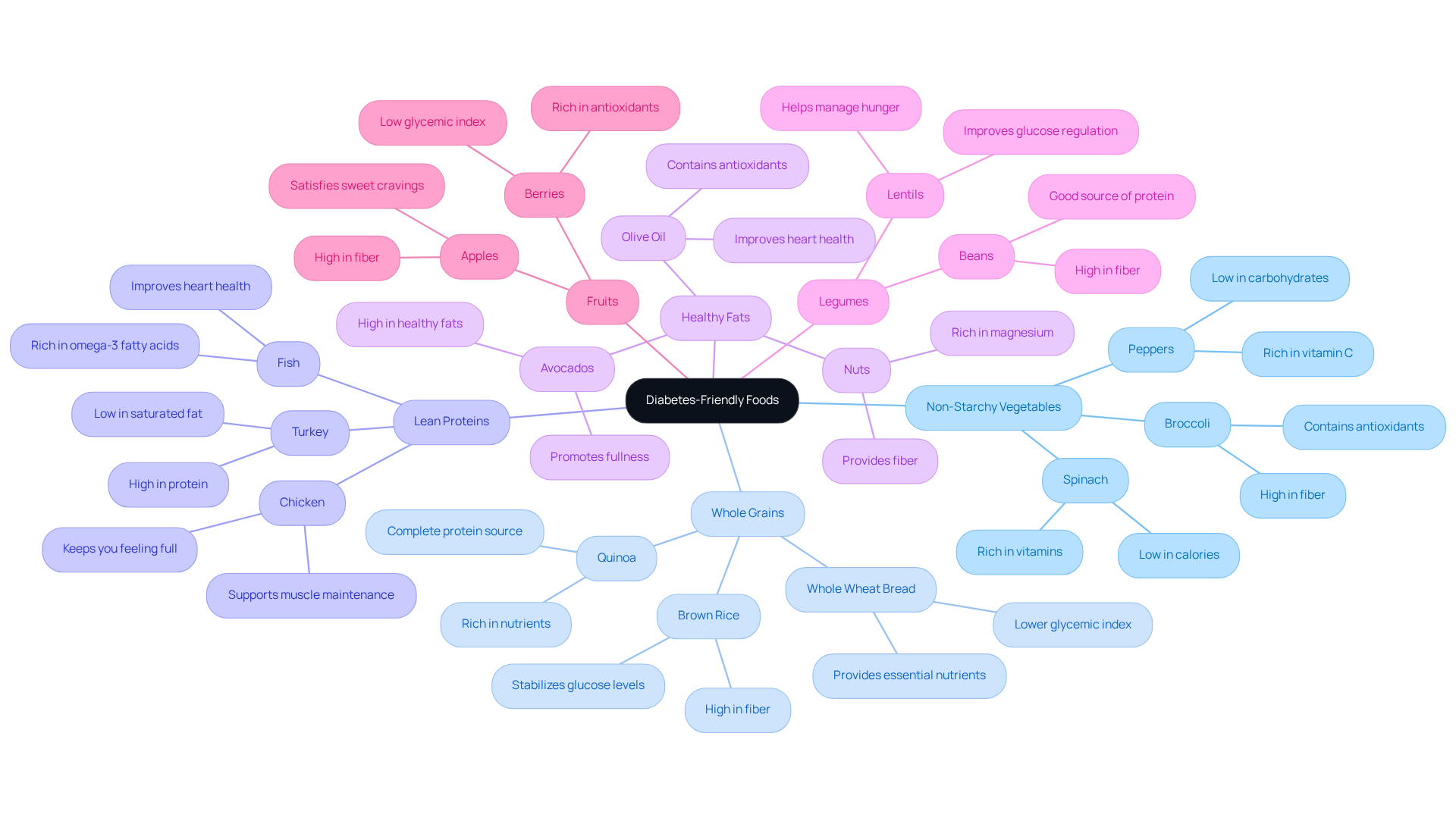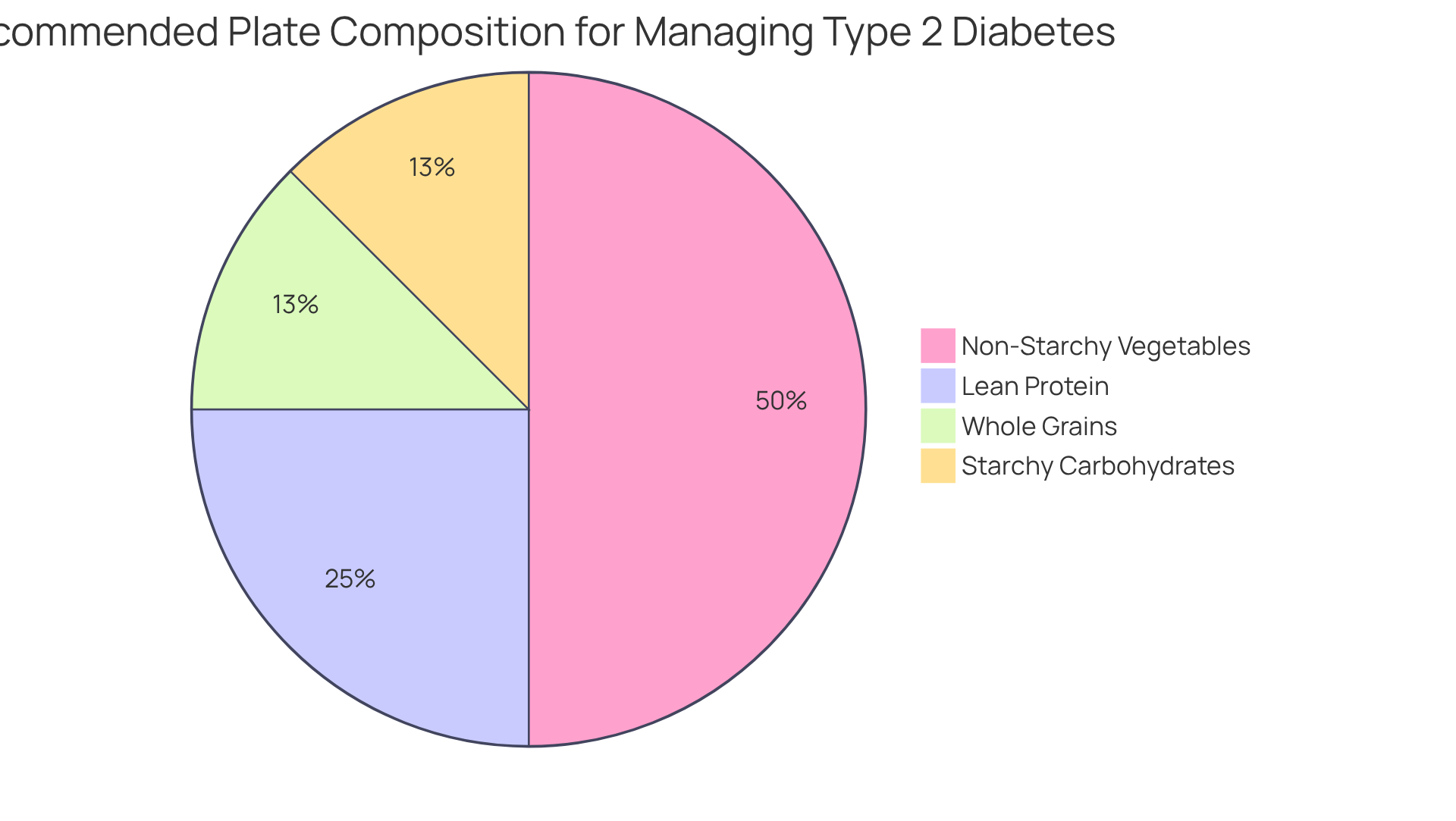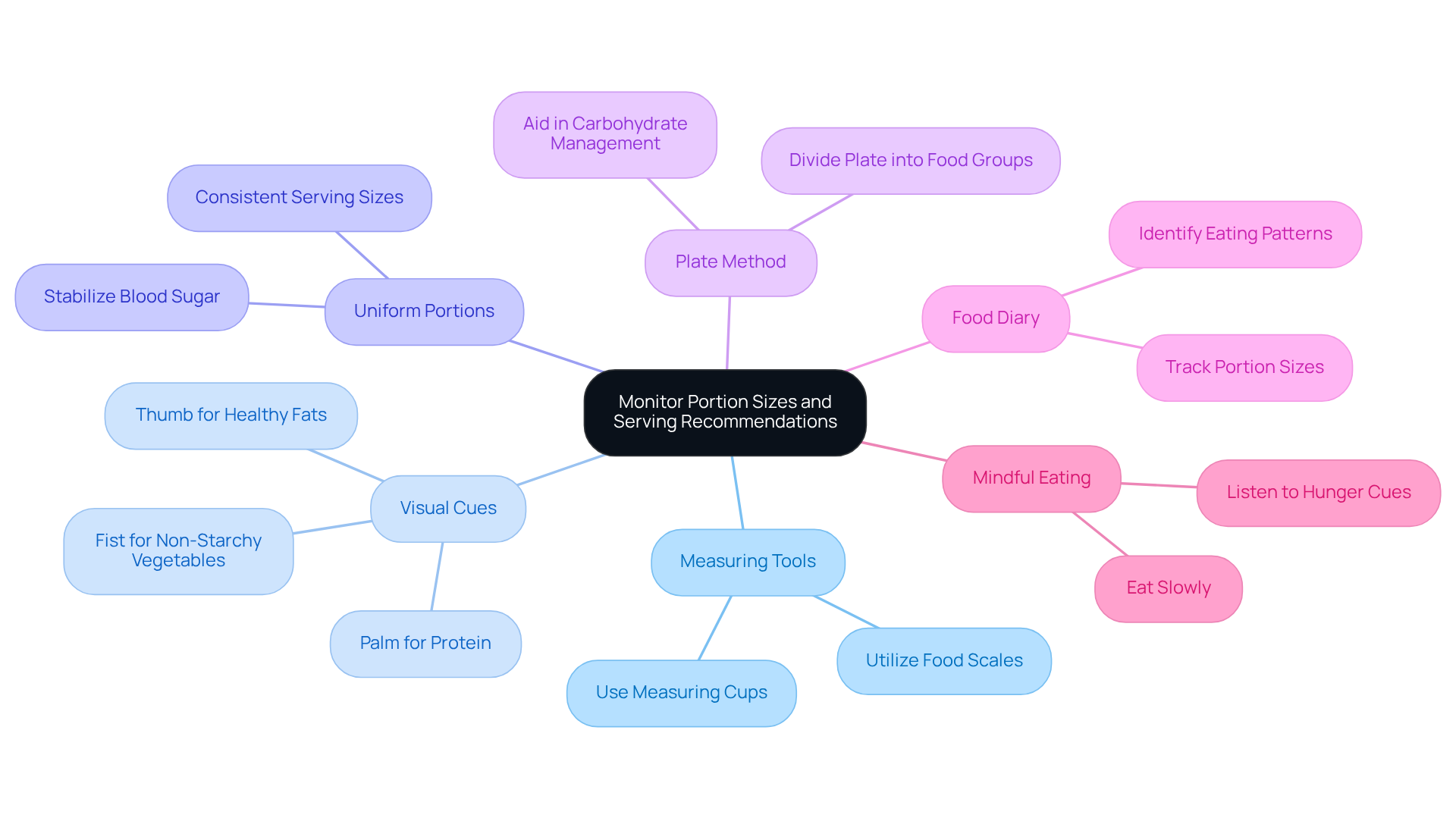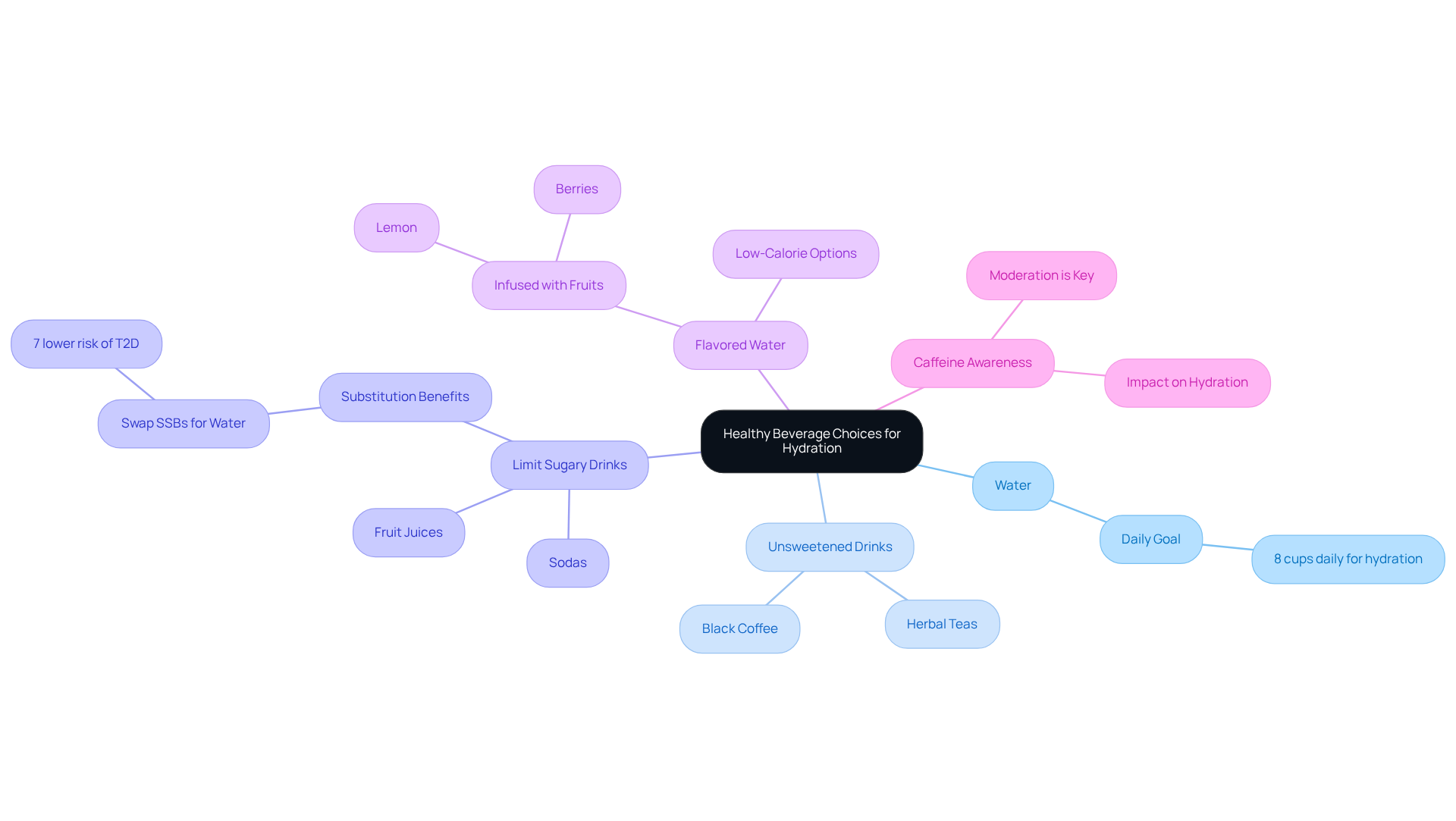Overview
If you or someone you care about is navigating the challenges of type 2 diabetes, it’s important to know that there are food choices that can truly make a difference. This article highlights ten foods that can support your journey, including:
- Non-starchy vegetables
- Whole grains
- Lean proteins
- Healthy fats
- Legumes
- Low-glycemic fruits
These options not only help stabilize glucose levels but also promote overall health.
Understanding the nutritional benefits of these foods is key. They can play a vital role in managing diabetes effectively, and it’s essential to consider portion control as part of your approach. Remember, you’re not alone in this journey; many have walked this path and found success through mindful eating.
As you explore these food choices, think about how they can fit into your daily routine. It’s okay to feel overwhelmed, but taking small steps can lead to significant changes. We are here to support you every step of the way, encouraging you to seek out resources and community support that can empower you on this journey.
Introduction
Navigating the world of food choices can feel particularly daunting for those managing Type 2 Diabetes. But with the right information, it becomes possible to enjoy a diverse and satisfying diet while effectively managing blood sugar levels. In this article, we will explore ten essential foods that not only support diabetes management but also enhance your overall health and well-being.
What are the best options to incorporate into your daily meals that can help maintain stable glucose levels and prevent the common pitfalls of unhealthy eating? You're not alone in this journey, and together, we can find the right path to a healthier lifestyle.
Identify Diabetes-Friendly Foods
Including non-starchy vegetables like spinach, broccoli, and peppers in your meals is a wonderful choice. These vegetables are low in calories and carbohydrates, yet rich in essential vitamins and minerals. Aim for these to make up half of your dish, as this can encourage improved glucose management and overall wellness. Remember, you’re not alone in navigating these dietary changes; we’re here to support you.
Whole grains, such as brown rice, quinoa, and whole wheat bread, are another great option. They provide fiber and nutrients that help stabilize glucose levels. Choosing whole grains over refined grains is beneficial, as they have a lower glycemic index and contribute positively to diabetes management. It’s understandable to feel uncertain about these choices, but taking small steps can lead to significant improvements.
Incorporating lean proteins like chicken, turkey, and fish is vital for muscle maintenance and can help keep you feeling full. Aim for protein to occupy one-quarter of your plate, ensuring balanced meals that support your dietary needs. This approach can make a real difference in how you feel throughout the day.
Healthy fats from sources like avocados, nuts, and olive oil are also important. These fats can improve heart health and provide a sense of fullness, making them essential for anyone asking, 'I have type 2 diabetes what can I eat' in a diabetes-friendly diet. It’s reassuring to know that you can enjoy satisfying foods while managing your health.
Don’t forget to add legumes such as beans and lentils to your meals. They are excellent sources of fiber and protein, helping to manage hunger and improve glucose regulation. You might find that these foods not only nourish your body but also add variety to your meals.
When it comes to fruits, opt for those with a low glycemic index, like berries and apples. They can satisfy your sweet cravings without causing significant spikes in glucose levels. Whole fruits are preferred over juices due to their fiber content, which aids in stabilizing glucose levels. Remember, it’s okay to indulge your sweet tooth in a mindful way.
Lastly, it’s wise to avoid processed foods high in sugar and refined carbohydrates, as they can lead to rapid increases in blood glucose levels. Instead, focus on whole, nutrient-dense foods that support your health and diabetes management, as I have type 2 diabetes what can I eat. You’re taking important steps toward a healthier lifestyle, and every small change counts.

Plan Balanced Meals with Carbohydrates
Managing Type 2 Diabetes can feel overwhelming, but with a little planning and guidance on what to eat when I have type 2 diabetes, I can take control of my health. One effective way to do this is by using a visual portioning method for your meals. Imagine filling half your plate with vibrant non-starchy vegetables, one-quarter with lean protein, and the remaining quarter with whole grains. Starchy carbohydrates should make up about a quarter of your plate. By choosing high-fiber carbohydrate sources like oats and legumes, you can help slow glucose absorption, maintaining stable levels of glucose in your bloodstream. It's wise to limit refined carbohydrates, such as white bread and sugary cereals, as they can lead to quick spikes in glucose levels.
Healthy snacks can also play a significant role in managing your glucose levels. For instance, Greek yogurt paired with berries is not only delicious but also a wholesome choice. As Lindsay Cohen, a Registered Dietitian, wisely notes, "Carbohydrate counting is a powerful tool to help promote balanced meals." Don't forget to include cultural foods in your meal planning, as they can make your diet more enjoyable and diverse.
By focusing on these strategies and understanding portion sizes, you're taking important steps toward creating meal plans that meet your dietary needs, especially considering that I have type 2 diabetes what can I eat, while enhancing your overall health and well-being. Remember, you're not alone in this journey; we are here to support you every step of the way.

Monitor Portion Sizes and Serving Recommendations
-
To effectively manage diabetes, it's important to utilize measuring cups or a food scale for accurate serving sizes. These precision tools help ensure that you consume the exact amount needed to maintain stable glucose levels, which is crucial for your health.
-
You might find it helpful to familiarize yourself with visual cues for portion sizes: a fist represents a cup of non-starchy vegetables, a palm indicates a serving of protein, and a thumb signifies healthy fats. These simple cues can make portion control easier and enhance your meal planning.
-
Striving for uniform portion sizes at every meal can assist in stabilizing your blood sugar readings. Fluctuations in glucose levels can lead to health challenges, so controlling portion sizes is key in preventing both elevated and reduced glucose amounts.
-
Consider trying the plate method, which divides your plate into portions for different food groups. This approach can aid in carbohydrate management and promote balanced meals, helping you feel more in control of your diet.
-
Keeping a food diary can be a valuable tool for monitoring portion sizes and identifying patterns in your eating habits. This practice can provide insights into necessary adjustments for better glucose control. Additionally, practicing mindful eating—by listening to your hunger cues and eating slowly—can lead to reduced food intake, making your journey a little easier. Remember, you're not alone in this journey; we are here to support you every step of the way.

Stay Hydrated with Healthy Beverage Choices
-
Water should be your go-to beverage, with a goal of at least 8 cups daily to keep your body hydrated and promote overall health. It's important to note that, according to the National Health and Nutrition Examination Survey from 2015 to 2018, many adults in the US fell short of these recommendations. This highlights the need for greater awareness around hydration.
-
Consider opting for unsweetened drinks like herbal teas or black coffee. These options provide flavor without the added sweeteners that can raise glucose levels. As nutritionist Amanda Quinne wisely points out, 'Choosing beverages wisely is crucial for managing diabetes effectively, particularly when I have type 2 diabetes what can I eat.'
-
It's best to limit sugary drinks, such as sodas and fruit juices, if I have type 2 diabetes what can I eat. These can cause quick spikes in glucose levels, which raises the question for me, as I have type 2 diabetes, what can I eat to manage my condition more effectively? A simple yet effective change is swapping out one serving of sugar-sweetened beverages for plain water, which can lower the risk of developing Type 2 diabetes.
-
You might also enjoy low-calorie flavored waters or infusing plain water with fruits like lemon or berries. These refreshing alternatives can make hydration more enjoyable without adding extra calories.
-
Be aware of your caffeine intake, as it can affect both hydration and blood sugar control. Moderation is essential; research shows that too much caffeine can lead to dehydration, complicating diabetes management. Remember, you’re not alone in this journey, and small changes can make a big difference.

Conclusion
Incorporating diabetes-friendly foods into your daily meals is essential for effectively managing Type 2 diabetes. By focusing on non-starchy vegetables, whole grains, lean proteins, healthy fats, and low-glycemic fruits, you can create balanced meals that promote better glucose control and overall health. Understanding how to structure your meals and make informed food choices empowers you to navigate your dietary needs with confidence.
This article highlights key strategies for meal planning, including:
- The importance of portion sizes
- The visual plate method
- The role of hydration
Utilizing measuring tools and practicing mindful eating can significantly enhance glucose regulation, while opting for healthy beverages supports your overall wellness. These insights serve as practical guidance for anyone seeking to improve their dietary habits in the context of diabetes management.
Ultimately, embracing these dietary practices not only aids in controlling blood sugar levels but also contributes to a healthier lifestyle. By taking small, consistent steps toward incorporating these foods and strategies, you can make a meaningful impact on your health. Remember, every choice counts, and seeking support along the way can lead to lasting positive changes. You're not alone in this journey, and we are here to support you every step of the way.
Frequently Asked Questions
What types of vegetables are recommended for a diabetes-friendly diet?
Non-starchy vegetables like spinach, broccoli, and peppers are recommended. They are low in calories and carbohydrates but rich in essential vitamins and minerals.
How should vegetables be incorporated into meals for better glucose management?
Aim for non-starchy vegetables to make up half of your dish, as this can encourage improved glucose management and overall wellness.
What are some good whole grain options for managing diabetes?
Whole grains such as brown rice, quinoa, and whole wheat bread are great options. They provide fiber and nutrients that help stabilize glucose levels.
Why are whole grains preferred over refined grains?
Whole grains have a lower glycemic index compared to refined grains, which contributes positively to diabetes management.
What role do lean proteins play in a diabetes-friendly diet?
Lean proteins like chicken, turkey, and fish are vital for muscle maintenance and can help keep you feeling full. Aim for protein to occupy one-quarter of your plate for balanced meals.
What are some healthy fat sources that can be included in meals?
Healthy fats from sources like avocados, nuts, and olive oil are important. They can improve heart health and provide a sense of fullness.
How do legumes contribute to a diabetes-friendly diet?
Legumes such as beans and lentils are excellent sources of fiber and protein, helping to manage hunger and improve glucose regulation.
What types of fruits are suitable for individuals with diabetes?
Fruits with a low glycemic index, like berries and apples, are suitable as they satisfy sweet cravings without causing significant spikes in glucose levels.
Why is it better to choose whole fruits over fruit juices?
Whole fruits are preferred over juices due to their fiber content, which aids in stabilizing glucose levels.
What foods should be avoided in a diabetes-friendly diet?
Processed foods high in sugar and refined carbohydrates should be avoided, as they can lead to rapid increases in blood glucose levels. Focus on whole, nutrient-dense foods instead.



